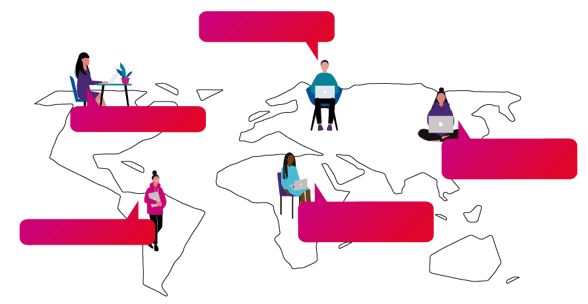E-Learning stands as a pillar of modern education and training, offering unparalleled flexibility and accessibility to learners worldwide, regardless of their location, education level, age, or background. However, there's still a significant barrier to consider when we target global audiences: the language barrier. Organizations aiming to reach multilingual audiences should put localization on their top priority list.
The intricacies of localization
Effective communication lies at the heart of E-Learning. If we fail to communicate in an accessible and effective manner, then the whole essence of E-learning is lost. Localization goes beyond simple text translation. It involves adapting content, visuals, audios, and formatting to suit the target locale. The goal is to make users feel as if a digital product was originally created in their region. Embarking on multilingual training programs presents therefore unique challenges.
Planning and Adaptation
Organizations need to plan the content creation process well in advance, ideally conducting thorough research on target groups' language preferences, proficiency levels, and cultural norms. By understanding these aspects, organizations can tailor their training content and methodologies to resonate with users' linguistic and cultural backgrounds, reducing misunderstandings and obstacles in the localization process. Moreover, E-Learning often covers topics with legal or regulatory implications which should be adapted to meet the specific requirements of different regions, providing learners with accurate and compliant information.
Cultural References and Contexts
A successful localization incorporates local cultural references and contexts to enhance learners' motivation. Familiar examples and scenarios make the learning process more enjoyable and comprehensible. By addressing specific regional challenges and industry practices, the learning outcomes are maximized, promoting a more direct application of the content in learners' professional or personal contexts.
If you want to have a broader overview on what localization means and our tips for successfully localizing E-learning content have a look at our blog article: https://blog.learnchamp.com/en/localization-of-e-learning-courses.

Integration of AI in Localization
While creating multilingual training programs is often viewed as expensive and time-consuming, recent advancements in AI tools offer promising ways to optimize the localization process, reducing time and costs. Le’s have a look together.
With automated translation and natural language processing, AI tools like DeepL or ChatGPT can swiftly adapt text content for diverse audiences. Glossary management ensures consistency and quality assurance algorithms catch errors, ensuring top-notch translations. These tools also grasp context, delivering more accurate adaptations. Moreover, AI personalization tailors content to individual preferences, enhancing user engagement. As a result, AI simplifies localization but also elevates its consistency, making it a game-changer in the realm of global communication.
Translation Management Systems (TMS)
If your organization has a lot of content to localize, the use of Translation Management Systems (TMS) like XTM may be your strategic allies. TMS are act like a command center, offering a bird's-eye view of the entire localization process. From the initial content extraction to the final polished translations, every step is meticulously tracked and managed with precision. No more scattered documents or chaotic workflows. One of the TMS's superpowers? Consistency. With a centralized glossary and terminology management, you can bid farewell to translation mishaps and hello to uniformity across all your content.
Multimedia in E-Learning and AI
Video and audios are a favored format for E-learning audiences due to their engaging nature. Videos convey complex concepts in a clear and concise manner, enhancing comprehension and retention. Before the advent of AI-driven video tools, the process of making videos available in different languages involved a combination of manual and automated steps, which could be complex and time-consuming. When making a learning video available in multiple languages synchronization of the various types of content on screen is crucial. Voiceover and multiple retakes whenever the content needs to be updated usually brings the cost to the roofs. AI-generated videos allow to create audios in multiple languages, synchronize them to the visuals and quickly adapt them whenever changes are needed without having to go through expensive voiceover services. This makes multiple filming attempts and recording errors a thing of the past. Some examples for AI-tools are Storyshell and Colossyan, but also Vyond with AI-features for illustrated videos.
Significance of human expertise
It's important to remember that while AI tools excel in efficiency, human intervention remains indispensable to ensure accuracy and cultural sensitivity criteria are met. Every piece of AI-generated content should undergo rigorous quality checks by human local experts to uphold standards of authenticity in monolingual as well as in multilingual communication.
Summary and Outlook
In conclusion, E-Learning offers unparalleled accessibility, yet the language barrier remains a significant obstacle for global outreach. Localization, powered by AI and human expertise, emerges as a critical solution. By tailoring content to diverse audiences' linguistic and cultural backgrounds, organizations can bridge gaps and empower learners worldwide. Recent advancements in AI technology, streamline the localization process, reducing costs and errors. Together, AI and human expertise pave the way for a future where learning knows no boundaries.
Ready to localise your e-learning content but unsure where to start?
Contact us now and together we'll find a suitable solution for your localisation needs!


